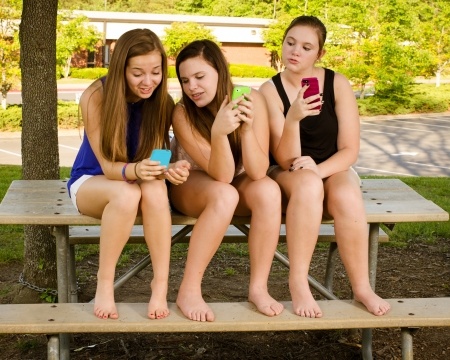Most parents worry that kids spend too much time on their phones. There are steps you can take to help them unplug.
Last week, my family spent a week at the beach. Of course the sun, sand and surf were amazing. However, what I loved most about our trip was that our daughters unplugged. No WIFI. No Instagram. No texting. Yes, I’ll admit, at first they were a bit lost. But it was great to see how they used the time once the initial discomfort wore off. My 12 year-old spent hours body surfing, boogie boarding and reading. My 8 year-old dug for sand crabs, splashed in the waves and built sandcastles. They were both so present and in the moment.

I have to admit, it took me a while to adjust as well. But before long, I was having so much fun playing games, making jewelry, swimming, reading and coloring. I didn’t realize how nice it would be to take a vacation from technology.
If your kids are like most, they spend a huge amount of time on their devices over summer. I get it. It’s easier sometimes to let them plug-in. But you will be amazed at the creativity that is born from tech-free time.
5 Ways to Help your Child Unplug:
- Create an “Unplugged” Schedule: Set a time during the day that is technology-free. No ipads, cell phones, video games, etc. Most likely your child will not think this is a great idea. That’s okay. If your child is short on ideas, you can suggest they invite over a friend, bake something, do an art project, play a board game, ride bikes, or go for a swim. The ideas are endless once they start brainstorming.

- Family Time: Our less-scheduled summer days are the perfect time to do something fun together Play a board game, go to the river, take a hike, go on a picnic. Keep in mind, it’s really important to put your devices away too. We model the behavior we expect from our kids and they will definitely notice if we aren’t unplugging as well.

- Get Out Into The Community: Check your local events calendar to see what’s going on around town. The summer months are full of outdoor concerts, picnics, reading programs and day camps. Many of these events are free. Encourage your child to leave their phone at home and enjoy the day.
- Allow Boredom: I’m sure you’ve all heard it: “I’m bored!” Devices are a quick go-to response for many of us. However, allowing your child to be “bored” usually inspires them to do something much more creative.
- Tech-Time: Allow some time during the day where they can use technology. Whether it’s texting friends, watching a show or playing a video game, let them have some space to plug-in. Kids miss their friends when school is out and often times social media is the easiest way for them to connect. It’s okay to give them some time to interact as long as there are limits.
I’d love to hear from you. How have you helped your child unplug? What obstacles did you face? How did you overcome them? Click here to comment on my Facebook Page. As parents, we can all learn from each other.





